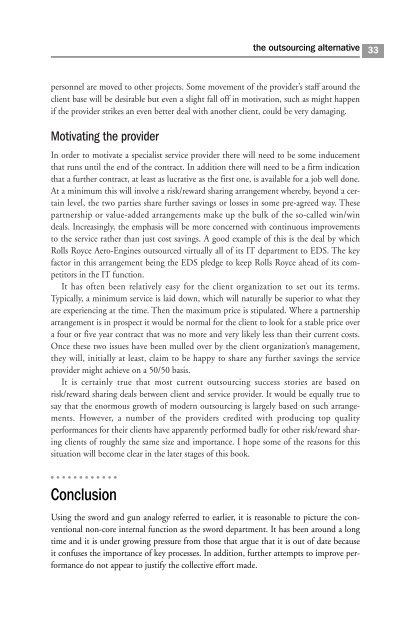The Outsourcing Dilemma - The Search for Competitiveness.pdf
The Outsourcing Dilemma - The Search for Competitiveness.pdf
The Outsourcing Dilemma - The Search for Competitiveness.pdf
Create successful ePaper yourself
Turn your PDF publications into a flip-book with our unique Google optimized e-Paper software.
the outsourcing alternative 33<br />
personnel are moved to other projects. Some movement of the provider’s staff around the<br />
client base will be desirable but even a slight fall off in motivation, such as might happen<br />
if the provider strikes an even better deal with another client, could be very damaging.<br />
Motivating the provider<br />
In order to motivate a specialist service provider there will need to be some inducement<br />
that runs until the end of the contract. In addition there will need to be a firm indication<br />
that a further contract, at least as lucrative as the first one, is available <strong>for</strong> a job well done.<br />
At a minimum this will involve a risk/reward sharing arrangement whereby, beyond a certain<br />
level, the two parties share further savings or losses in some pre-agreed way. <strong>The</strong>se<br />
partnership or value-added arrangements make up the bulk of the so-called win/win<br />
deals. Increasingly, the emphasis will be more concerned with continuous improvements<br />
to the service rather than just cost savings. A good example of this is the deal by which<br />
Rolls Royce Aero-Engines outsourced virtually all of its IT department to EDS. <strong>The</strong> key<br />
factor in this arrangement being the EDS pledge to keep Rolls Royce ahead of its competitors<br />
in the IT function.<br />
It has often been relatively easy <strong>for</strong> the client organization to set out its terms.<br />
Typically, a minimum service is laid down, which will naturally be superior to what they<br />
are experiencing at the time. <strong>The</strong>n the maximum price is stipulated. Where a partnership<br />
arrangement is in prospect it would be normal <strong>for</strong> the client to look <strong>for</strong> a stable price over<br />
a four or five year contract that was no more and very likely less than their current costs.<br />
Once these two issues have been mulled over by the client organization’s management,<br />
they will, initially at least, claim to be happy to share any further savings the service<br />
provider might achieve on a 50/50 basis.<br />
It is certainly true that most current outsourcing success stories are based on<br />
risk/reward sharing deals between client and service provider. It would be equally true to<br />
say that the enormous growth of modern outsourcing is largely based on such arrangements.<br />
However, a number of the providers credited with producing top quality<br />
per<strong>for</strong>mances <strong>for</strong> their clients have apparently per<strong>for</strong>med badly <strong>for</strong> other risk/reward sharing<br />
clients of roughly the same size and importance. I hope some of the reasons <strong>for</strong> this<br />
situation will become clear in the later stages of this book.<br />
Conclusion<br />
Using the sword and gun analogy referred to earlier, it is reasonable to picture the conventional<br />
non-core internal function as the sword department. It has been around a long<br />
time and it is under growing pressure from those that argue that it is out of date because<br />
it confuses the importance of key processes. In addition, further attempts to improve per<strong>for</strong>mance<br />
do not appear to justify the collective ef<strong>for</strong>t made.















